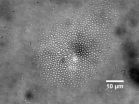(Press-News.org) Athens, Ga. – On the list of undesirable medical conditions, a parasitic worm infection surely ranks fairly high. Although modern pharmaceuticals have made them less of a threat in some areas, these organisms are still a major cause of disease and disability throughout much of the developing world.
But parasites are not all bad, according to new research by a team of scientists now at the University of Georgia, the Harvard School of Public Health, the Université François Rabelais in Tours, France, and the Central South University, Changsha, Hunan, China.
A study published recently in Nature Medicine demonstrates that once inside a host, many parasitic worms secrete a sugar-based anti-inflammatory molecule that might actually help treat metabolic disorders associated with obesity.
The sugar molecule, or glycan, is released by parasites to help them evade the body's immune system. By reducing inflammation, they are better able to hide in tissues, and humans experience fewer symptoms that might reveal their presence.
"Obesity is an inflammatory disease, so we hypothesized that this sugar might have some effect on complications related to it," said Donald Harn, study co-author who worked on the research while at Harvard School of Public Health and is now Georgia Research Alliance Distinguished Investigator in the UGA College of Veterinary Medicine's Department of Infectious Diseases.
The researchers tested their hypothesis on mice fed a high-fat diet. Those in the control group exhibited many of the symptoms associated with excessive weight gain, such as insulin resistance, high triglycerides and high cholesterol.
Mice that received treatment with the sugar still gained weight, but they did not suffer the same negative health effects as those in the control.
"All of the metabolic indicators associated with obesity were restored to normal by giving these mice this sugar conjugate," said Harn, who is also a member of UGA's Faculty of Infectious Diseases and the Center for Tropical and Emerging Global Diseases. "It won't prevent obesity, but it will help alleviate some of the problems caused by it."
The same sugars excreted by the parasites are also found in the developing human fetus and in human breast milk, which Harn suspects may establish proper metabolic functions in the newborn infant. Beyond infancy, however, sugar expression is only found on a few cells, and the only external source for the sugar is parasitic worms.
Because parasites co-evolved with mammals over millions of years, some scientists believe that the relationship between humans and worms is more symbiotic than parasitic, and that small worm infections might actually have some benefits.
"Prevalence of inflammation-based diseases is extremely low in countries where people are commonly infected with worms," Harn said. "But the minute you start deworming people, it doesn't take too long for these autoimmune diseases to pop up."
This doesn't mean that people should actively seek out parasitic infections as treatment, he said. But it is an indication that the compounds secreted by worms may serve as the basis for future therapies.
In addition to obesity-related disease, Harn and his colleagues have demonstrated that the sugar molecule released by parasites may alleviate a number of other serious inflammatory medical conditions.
It may work as a treatment for psoriasis, a disease that causes skin redness and irritation. The sugar also appears to serve as a powerful anti-rejection drug that may one day be used in patients who have received organ transplants. And it has been shown to halt or even reverse the symptoms of multiple sclerosis in mice.
More research is needed before this sugar molecule can be tested in humans, but Harn and his colleagues are hopeful that they can create effective treatments that provide all the benefits of parasitic worms without the worms themselves.
"We see great promise in this sugar, and we hope that future research and collaborations will eventually lead to marketable therapies for people suffering from disease," he said.
###
UGA Faculty of Infectious Diseases
The University of Georgia Faculty of Infectious Diseases was created in 2007 to address existing and emerging infectious disease threats more effectively by integrating multidisciplinary research in animal, human and ecosystem health. Researchers from across the university focus on epidemiology, host-pathogen interactions, the evolution of infectious diseases, disease surveillance and predictors and the development of countermeasures such as vaccines, therapeutics and diagnostics. For more information about the Faculty of Infectious Diseases, see http://fid.ovpr.uga.edu.
UGA College of Veterinary Medicine
The UGA College of Veterinary Medicine, founded in 1946, is dedicated to training future veterinarians, conducting research related to animal and human diseases and providing veterinary services for animals and their owners. Research efforts are aimed at enhancing the quality of life for animals and people, improving the productivity of poultry and livestock and preserving a healthy interface between wildlife and people in the environment they share. The college enrolls 102 students each fall out of more than 800 who apply. For more information, see www.vet.uga.edu.
Writer: James Hataway, 706/542-5222, jhataway@uga.edu
Contact: Donald Harn, 706/542-4569, dharn@uga.edu
END
The research carried out at IIASA in collaboration with the Potsdam Institute for Climate Impact Research demonstrates that there is fundamental rigidity, known as lock-in, within the energy economy that favors the use of fossil fuels and nuclear power despite their large environmental and social costs. The researchers identify that this rigidity of the existing energy economy could be considerably reduced by introducing new rules that hold shareholders of companies liable for the damages caused by the companies they own. Allocating the liability between the company and ...
The flick of an antenna may be how a male wasp lays claim to his harem, according to new research at Simon Fraser University.
A team of biologists, led by former PhD graduate student Kelly Ablard, found that when a male targeted a female, he would approach from her from the left side, and once in range, uses the tip of his antenna to tap her antenna.
Ablard suggests the act transfers a yet unidentified specimen-specific pheromone onto the female's antenna that marks the female as "out of bounds," or "tagged."
The tagging-pheromone helps a male relocate the females ...
Graphene oxide has a remarkable ability to quickly remove radioactive material from contaminated water, researchers at Rice University and Lomonosov Moscow State University have found.
A collaborative effort by the Rice lab of chemist James Tour and the Moscow lab of chemist Stepan Kalmykov determined that microscopic, atom-thick flakes of graphene oxide bind quickly to natural and human-made radionuclides and condense them into solids. The flakes are soluble in liquids and easily produced in bulk.
The experimental results were reported in the Royal Society of Chemistry ...
What if Noah got it wrong? What if he paired a male and a female animal thinking they were the same species, and then discovered they were not the same and could not produce offspring? As researchers from the Smithsonian's Panama Amphibian Rescue and Conservation Project race to save frogs from a devastating disease by breeding them in captivity, a genetic test averts mating mix-ups.
At the El Valle Amphibian Conservation Center, project scientists breed 11 different species of highland frogs threatened by the chytrid fungus Batrachochytrium dendrobatidis, which has already ...
The American Chemical Society (ACS), the world's largest scientific society, today launched a new video series that will feature noted scientists discussing the status of knowledge in their fields, their own research, and its impacts and potential impacts on society. Chemistry over Coffee: Conversations with Celebrated Scientists is available at www.acs.org/ChemistryOverCoffee.
The launch episode features Chad Mirkin, Ph.D., and Paul Weiss, Ph.D., internationally known leaders in nanotechnology. Mirkin, director of Northwestern University's International Institute for ...
New research reveals that a significant number of adolescents lose their protection from hepatitis B virus (HBV) infection, despite having received a complete vaccination series as infants. Results in the January 2013 issue of Hepatology, a journal published by Wiley on behalf of the American Association for the Study of Liver Diseases, suggest teens with high-risk mothers (those positive for HBeAg) and teens whose immune system fails to remember a previous viral exposure (immunological memory) are behind HBV reinfection.
Infection with HBV is a major global health concern ...
CORVALLIS, Ore. – Cervical cancer rates for Hmong women are among the highest in the nation, yet past research has shown that cervical and breast cancer screening rates for this population are low – in part because of the Hmong's strong patriarchal culture.
However, a new study by Oregon State University researchers examining attitudes regarding breast and cervical cancer screening among Oregon's Hmong population shows a much more complicated picture. The study found that Hmong women often make their own health decisions, but in an environment in which screening is not ...
ANN ARBOR—In 2006, the lab of Dr. David Ginsburg at the Life Sciences Institute put a call out for siblings attending the University of Michigan to donate blood for a study of blood-clotting disorders.
The samples were collected over three years and have now enabled the researchers to identify the specific parts of the genome responsible for levels of a key substance for blood clotting. The findings were reported online Dec. 24 in the Proceedings of the National Academy of Sciences.
Von Willebrand disease is the most common hereditary blood-clotting disorder—it's more ...
ANN ARBOR, Mich. — Postpartum depression not only affects mothers but it could mean higher health risks for the baby – especially in low-income countries like Ghana where the condition isn't well-recognized, University of Michigan Health System research shows.
Efforts to reduce child mortality and improve infant growth, health, and nutritional status in less-developed countries must address the mental health of new moms, the study suggests.
Two-thirds of participating mothers of sick, hospitalized babies in Ghana showed high risk for symptoms of clinical depression ...
WEST LAFAYETTE, Ind. - Researchers have demonstrated a new technology that combines a laser and electric fields to create tiny centrifuge-like whirlpools to separate particles and microbes by size, a potential lab-on-a-chip system for medicine and research.
The theory behind the technology, called rapid electrokinetic patterning - or REP - has been described in technical papers published between 2008 and 2011. Now the researchers have used the method for the first time to collect microscopic bacteria and fungi, said Steven T. Wereley, a Purdue University professor of mechanical ...


